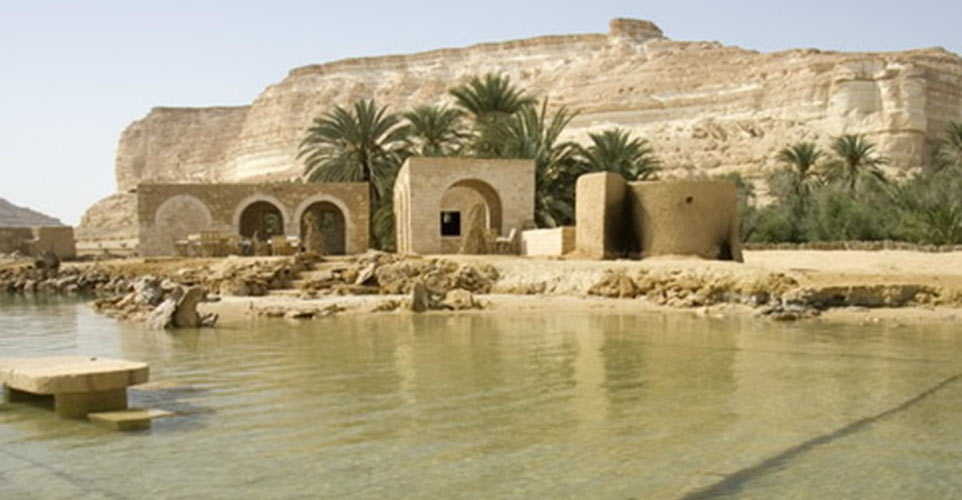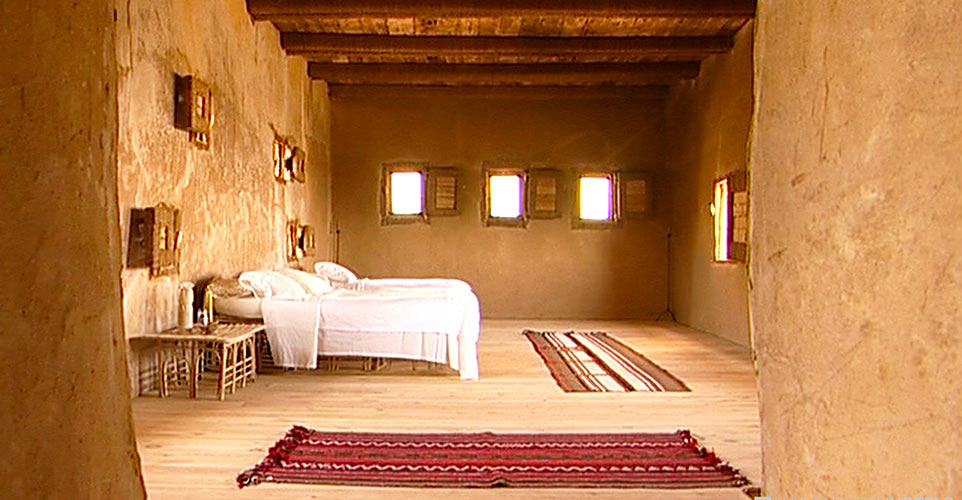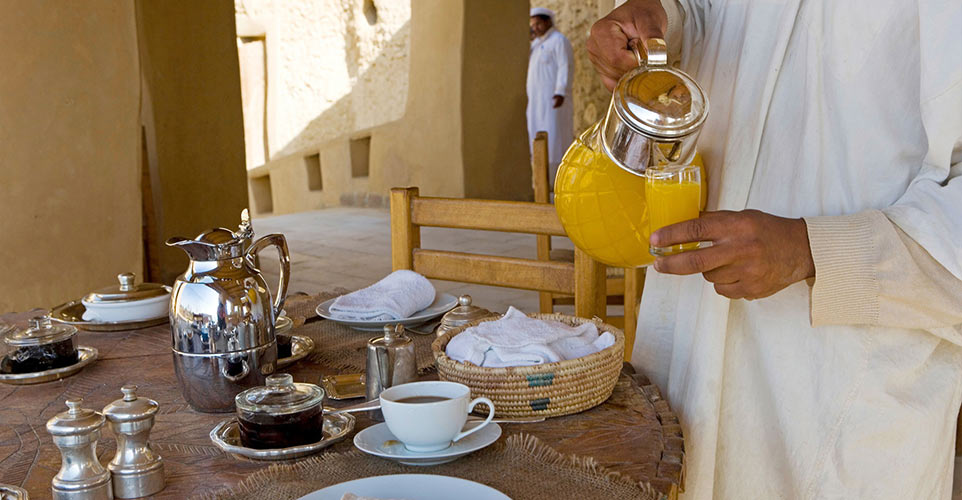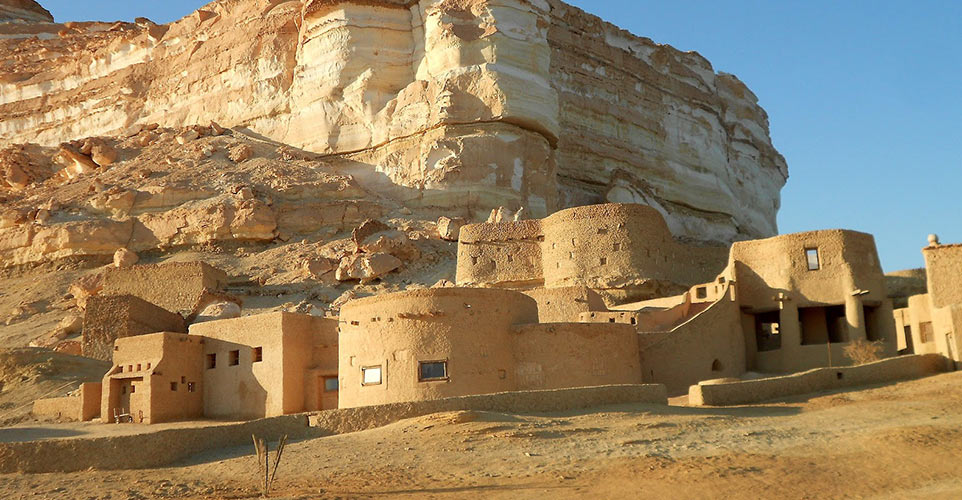The Adrere Amellal resort nestles at the foot of a majestic mountain, overlooking ancient olive and palm groves, Siwa’s largest salt lake, and the dunes of the Great Sand Sea. This unique eco-lodge offers travellers a return-to-nature experience in a unique oasis-like ecological and cultural setting.
The Adrere Amellal resort, which ranked second on Condé Nast Traveler's Green List of Best Resorts in 2005, has been built with utmost sensitivity to socio-cultural and environmental considerations. Derelict Siwan houses have been restored and extended, using kershef—a mixture of rock salt and mud—to build the walls. This method keeps indoor temperatures moderate and ensures that the structures blend with the environment. The premises are free of electricity and telephones, in keeping with the lifestyle of the oasis. Doors and windows are strategically positioned to capture the desert breeze, eliminating the need for air-conditioning. Oil lamps and candles are used for lighting, and braziers for heating.

The 34 rooms and suites are simply furnished, but quality is of a high standard. Furnishing is simple but of the finest quality, drawing exclusively on natural materials, traditional design, and local skills. A team of trained Siwan staff offer quality hospitality services. The eco lodge, a product of the ancient wisdom and creativity of Siwan master builders and craftsmen whose trades were becoming extinct, has led to a revival of traditional building techniques in the oasis. The rooms features hand-woven Bedouin carpets on the floors, doors built from palm trees, beds made of palm fronds (which are surprisingly comfy), and doors without keys. The food is traditional and ranges from pumpkin cous cous with lamb kebabs to a scrumptious date soufflé.

Mysterious Siwa
Siwa, once the most mysterious of all Egypt's oases, is also the most fascinating. Its history has not only been shaped by all major civilizations, but also by the contrast of the surrounding desert with the lush soil of the oasis setting. The Siwan people have their own culture and customs and, speak Arabic and Berber (Amazigh), the local language. Women still wear traditional costumes and silver jewellery and Siwa remains one of the best places to buy traditional local handicrafts.
As part of the official royal visit to Egypt, Britain's Prince Charles and his wife, Camilla Parker Bowles, the Duchess of Cornwall, visited Siwa, a patch of green at the heart of the Sahara desert. They had this to say after their visit: “It feels like living in a world, which is protected and hidden from the crowd. What I like the most is its beauty, vast spaces and the calmness. There are many breathtaking advantage points from where to view the undulating dunes of the desert in the distance. I really admire the way the place has conserved its old traditional values.
The modern town of Siwa is set among thick palm groves, walled gardens and olive orchards, with numerous freshwater springs and salt lakes. Siwa also clusters beneath the impressive remains of the ancient fortress town of Shali.

Activities include climbing through the ruins of the old city for magnificent views of the whole oasis; walking; hiring a bicycle or riding in a caretta (donkey cart) to outlying sights and bathing places; taking a dip in one of the many cool and refreshing springs; tasting traditional Siwan foods; enjoying a truly unforgettable and unique cultural experience.
Sights in the vicinity
The Temple of Amun is also known as the Temple of Oracle, one of the key tourist spots in the Siwa region. The Temple of Amun was named the Temple of Oracle because of Alexander's visit when he conquered Egypt. It is actually one of two temples dedicated to Amun at Siwa, the other being Umm Ubayda. The temple sits atop a flat rock, and is really spectacular.
Gebel (Jebel) al-Mawta in the Siwa Oasis of Egypt is also known as the Mountain of the Dead, because it is here in this conical mountain, a little over a kilometre to the north of Shali along the main road from the escarpment, that a number of tombs are situated. Local residents also call it Gebel (Qaret) al-Musabbarin (Missabbarin), meaning, Mountain of the Embalmed. The tombs cover every inch of its base and are situated on its terraces and on all sides of the conical part.
The fortification of Shali is located in the centre of modern Siwa in the Siwa Oasis, and is basically, the old town. Some of the buildings of the old town are still in use, but due to their construction from salt, mud, rock and plaster, they seem to be falling more into ruin each year. In fact, up until the extreme rains of 1926, much of the old town was still in use. The area dates from the 13th century.

Another attraction is Fatnas Island, which became a palm-fringed peninsula located on the edge of a saltwater lake. The lake had been partially drained in recent years due to a plan to limit the effect of rising water levels in Siwa due to agricultural runoff from uncontrolled wells (a major problem affecting the entire oasis), and Fatnas Island is now surrounded mostly by mud flats.
Variously known as “Cleopatra Spring”, “Ain Juba” or “Ain al Hammam,” in ancient times, it was known as “The Spring of the Sun.” Herodotus described its bubbling waters in his histories as boiling hot in the chilly evenings and remaining cool during the heat of the day. It was considered a wonder by ancients visiting Ammon. In reality, the spring’s waters are at a constant 29 C; it’s the changing air temperature and bubbling water that give the impression of boiling water.
Shali
Dominating the marketplace are the crumbling ruins of a 12th century fortress known as Shali. Siwans built it for protection from the hostile Bedouin tribes, who periodically raided the oasis. The walls and houses are constructed not from mudbrick but karsheef, a stone made of sun-baked clay, salt and fine sand which is dug from the edges of the salt lakes. Built atop a limestone hill, the fortress was quite solid and commanded a view of the open desert as well as the thousands of palm and olive trees that spill forth. The original fortress had three gates: the first, for the adjuwat or notables; the second, for the women; and the third for the general public. Inside the fortress walls was a thriving village, complete with streets and a well that’s large enough to satisfy its 700 inhabitants. Strangers were not allowed to enter the village, and the fortress was closed after dark as a safeguard against invaders.
Sand and stone, fire and sky, wind and water. Minimalism makes the maximum impact at this spectacular desert outpost. Inspired by the Berbers of yore, the 34 Casbah-style rooms are ingeniously fashioned from salt rock and clay, with stylish palm roofs shading guests from the blazing sun. Sans electricity, nights sparkle with candles and constellations. The flat-edged pool's water bubbles up from Roman springs. And with endless views of the dunes, visitors will want to stay a thousand and one nights...
Highlights of the region
- The Siwan region is the base for excursions into one of Africa's largest dune fields—the Great Sand Sea.
- The Siwa Lake, said to be as salty as the Dead Sea, and, therefore, excellent for the skin.
- The oasis developed largely independently of Egypt. With no proper road from the main coastal town until about 20 years ago, both visitors and Siwans needed permits to leave and enter the oasis.
- Siwa's two main exports—dates and olives—are its traditional economic mainstay. They also exemplify how contact with the outside world could improve living standards.
- The USP of this region is that no pesticides or artificial fertilizer have ever been used in the oasis. It is that purity that is Siwa's chief advantage and its greatest problem.
- Crops are grown on countless small allotments throughout the oasis and irrigated by the mineral water springs that bubble up from the earth.
